What is a Sonic Water Level Meter?
First, how does a sonic well sounder or non-contact sonic water level meter work?
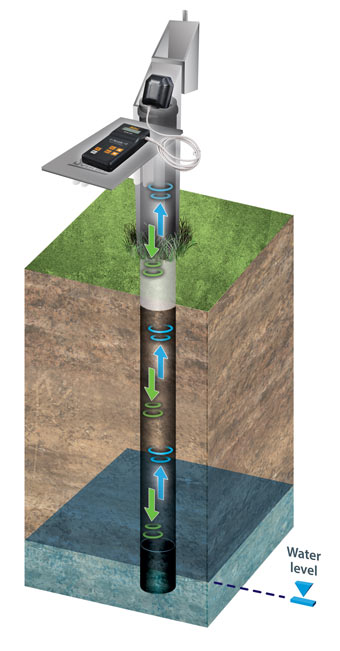
The Solinst Sonic Water Level Meter works by a probe at surface transmitting a low frequency sound wave into a pipe, tube, or well, and measuring the time it takes for the pulse to return after making contact with water.
The depth to water is calculated using the speed of sound and time. The depth to static water level is displayed on the LCD screen of the control unit after just a few seconds.
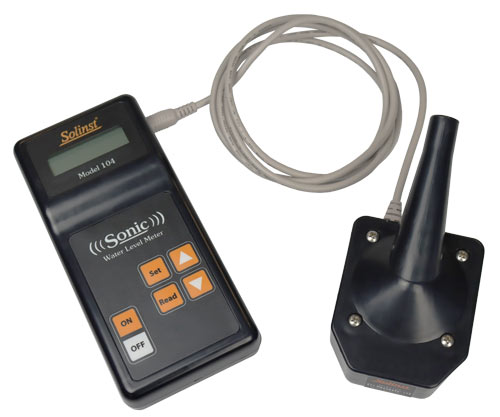
The accuracy of the reading depends on the acoustics of the well, which can be affected by anomalies like cracks in well casing, collars, borehole protrusions or irregularities, or other instruments down the well.
It also depends on how well you know the environment you are monitoring, and if you set up your Sonic Water Level Meter properly.
This post provides tips to address all of these factors, so you can get the most accurate reading from your Solinst Sonic Water Level Meter.
When should a Sonic Water Level Meter be used?
Let’s review situations where a Sonic Water Level Meter is most ideal for obtaining a depth to water level measurement.
Since the Sonic Water Level Meter works at the surface, and there is no need to lower anything down well, it is perfect for use in some specific scenarios:
- In crooked or obstructed wells where equipment can potentially be entangled
- At contaminated sites (concerns of cross contamination from well to well and decontamination of equipment)
- On sites where equipment is not allowed to enter the well or touch water surface
- When fast manual single point data collection is required
- In narrow, cascading, or difficult to access water level wells
Generally, when using a Sonic Water Level Meter, it is preferable if you already know some information about the well, borehole, pipe, or piezometer that you are measuring in.
If you are unfamiliar with your monitoring environment, you may want to consider using a standard Water Level Meter instead. Solinst offers a range of Water Level Meters that may be better suited to your application.
Solinst Water Level Meters feature an accurately marked tape every millimeter or 1/100th of a foot, so you are ensured that accuracy. An audible tone and light confirm you have hit water, and not some sort of obstruction in the well.
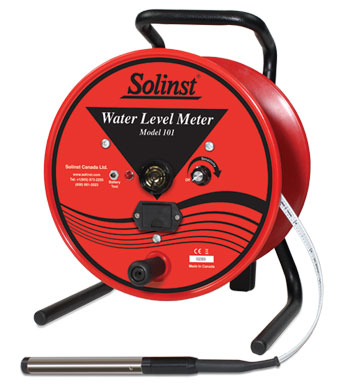
You can check out our handy chart that compares the Solinst Model 101 and the Model 104 Sonic Water Level Meter.
Sonic Water Level Meters can provide accurate depth to water level readings, especially if you follow the tips discussed next!
1) Ensure your well has the proper setup
If the top of your well or pipe is open, then it should be covered with a cap with a hole for the probe to access. Solinst includes a plastic disc with each Sonic Water Level Meter, providing a good option for covering larger well openings.
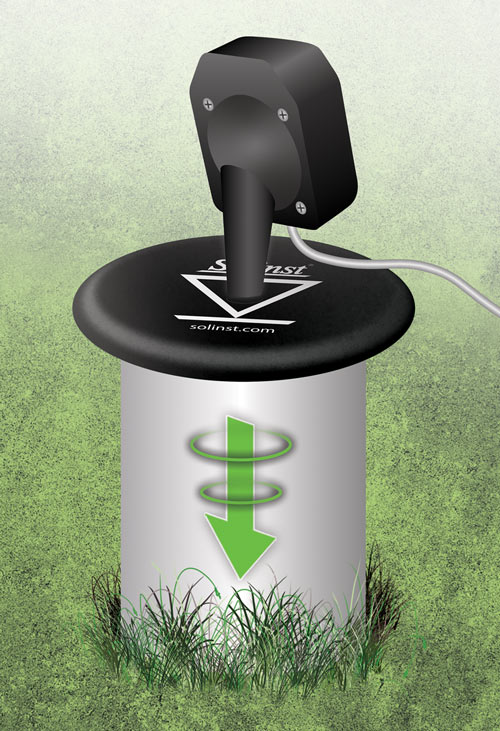
Why should you do this?
Since the pulse generated from the Sonic Water Level Meter probe is an air pressure wave/low frequency sound wave, there should be a good seal around the probe to prevent the air pressure from escaping the well, which can result in losing/weakening the pulse.
The seal around the probe does not have to be airtight, but the signal works better when the sound waves cannot escape and it also helps prevent external noise, such as wind, from interfering with the sound wave.
2) Limit and account for the diameter of the well you are measuring in
The Solinst Sonic Water Level Meter works best in wells or pipes with diameters of 8″ or less.
This is because, as well diameter increases, the strength of the sounds pulse weakens. Therefore, the pulse is more susceptible to pump noise or interference from other imperfections.
As such, wells larger than 8″ in diameter should use a drop tube from top of well, to below the depth to water for measurement.
Just as you need to account for larger diameters, you also need to consider that there is a reduced speed of sound in smaller than 2″ (5 cm) diameter wells or tubes.
To adjust for this, you can enter the drop tube diameter into the Sonic Water Level Meter control unit to compensate for the difference.
See the Model 104 Sonic Water Level Meter Instructions to learn how you can enter this and the other parameters that will be discussed in the upcoming tips.
3) Know the groundwater/deep well temperature
Since the speed of sound changes with temperature, there is a temperature sensor in the probe that will account for air temperature at the wellhead.
The Sonic Water Level Meter allows you to manually enter the estimated temperature at the air/water interface of your well.
With the air temperature automatically detected by the sensor in the probe, the two temperatures are used to calculate the speed of sound and therefore, the distance/depth to water.
Note: The distance error is small for variations in temperature, about 1% for a 10ºF (5.6 ºC) temperature error.
If you are unsure of the temperature in your well, there are online resources available, such as this US EPA map of average shallow groundwater temperatures, to help you estimate your groundwater temperature.
Note: you could also record an accurate downhole reading using a Solinst 201 Water Level Temperature Meter.
4) Be familiar with the typical depth to water in your well
In general, knowing the approximate water level before measuring allows you to set a minimum depth to start detecting, and a maximum depth to listen for the returning pulse.
For example, if depth to water is usually between 8–9 m, set your minimum to 7 m and your maximum to 10 m for higher accuracy.
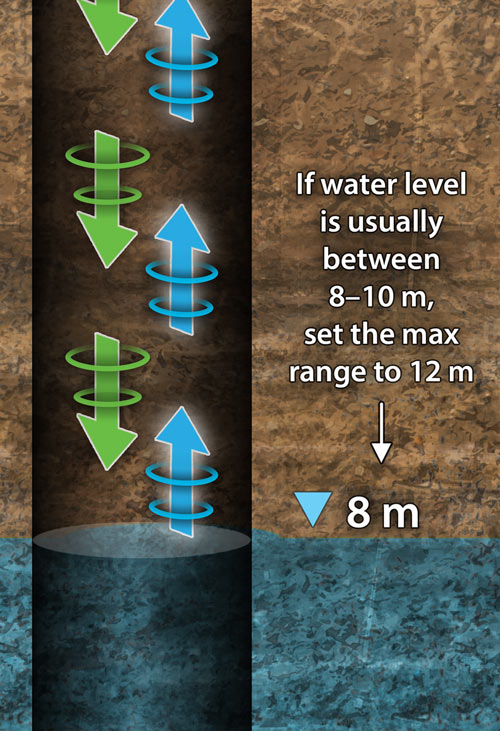
A bit more on this…
The sound wave loses energy as it travels. Well casing is rough or porous which can absorb some of the sonic pulses. This means weaker, less frequent returning pulses make the sound wave more susceptible to interference.
To compensate for this, the probe increases its gain with time to listen for fainter signals. This can cause problems if the probe listens for too long. The gain will get so high that pump noise or noise outside the well could outweigh the pulse. The maximum range setting is available to tell the probe how long to listen.
On the other hand, a shorter range means more frequent pulses returning to the probe. In shallow wells, the sound wave bounces off the top and bottom of the well, so the pulse can bounce back and forth many times.
So, if the approximate depth to water is known, set the maximum range to slightly deeper. Don’t set the Sonic Water Level Meter to listen for the returning pulses longer/deeper than required. Set the minimum range to avoid detecting return pulses from a shallower depth.
5) Know what’s down your well!
The maximum and minimum range setting discussed in the previous tip can also be used to help avoid interference from known obstructions in the well.
As described earlier, the sound wave from the probe travels until it is disturbed. Each time it is disturbed by an imperfection in the well, some of the pulse is reflected, making the main pulse a little weaker.
Smaller obstructions, like tubing or wires, will not obstruct the pulse enough to affect the water level reading. However, larger interferences such as a small change in casing diameter could reflect enough of the pulse to generate an inaccurate reading.
For example, if you know there is a crack or the well casing ends at 10 m and your water level is below that at about 20 m, then the minimum range could be set to 15 m to ignore any reflection at 10 m.
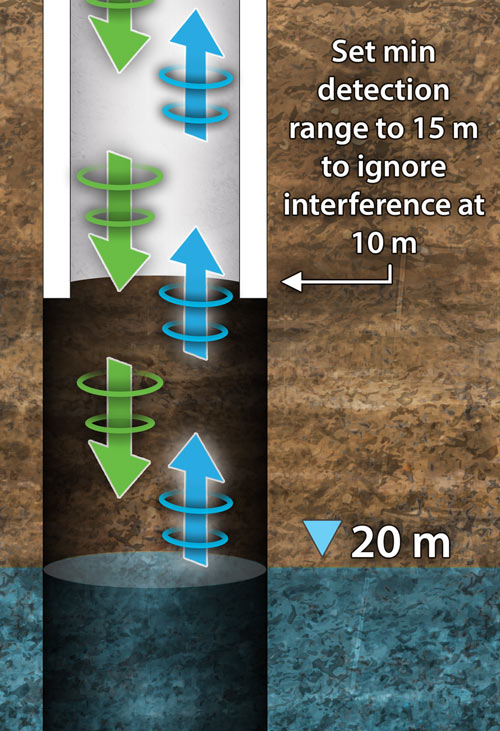
Note: a drop tube should be used if there are more significant disturbances in the well, such as a large step-down in well casing diameter or perforated casing sections.
In another example, if a pump is installed at 50 m, then set a maximum range of less than 50 m to avoid any interference from that depth.
A few other tips!
There are a few other steps you can take to ensure your readings are optimized.
You can ensure your battery level is in good shape. The Sonic Water Level Meter comes with 6 AA replaceable alkaline batteries. They should be replaced when they reach 6.5V. After you turn the control unit on, simply press the down arrow to check the voltage.
Note: you can set the control unit to Power Save mode to prolong the battery life.
Enter an offset. For example, if the probe is inserted into a well cap that extends 75 cm above the ground. Then enter 75 cm in the control unit for the offset. This will automatically be deducted from the depth reading. The value can be negative if the probe is installed on a casing below ground level.
Perform a Factory Reset. It is good practice to perform a Factory Reset before starting a new application (or at a minimum once a month). This sets the control unit back to the factory default configuration with measurements in metric, so you can start your next project fresh with any previous settings removed.
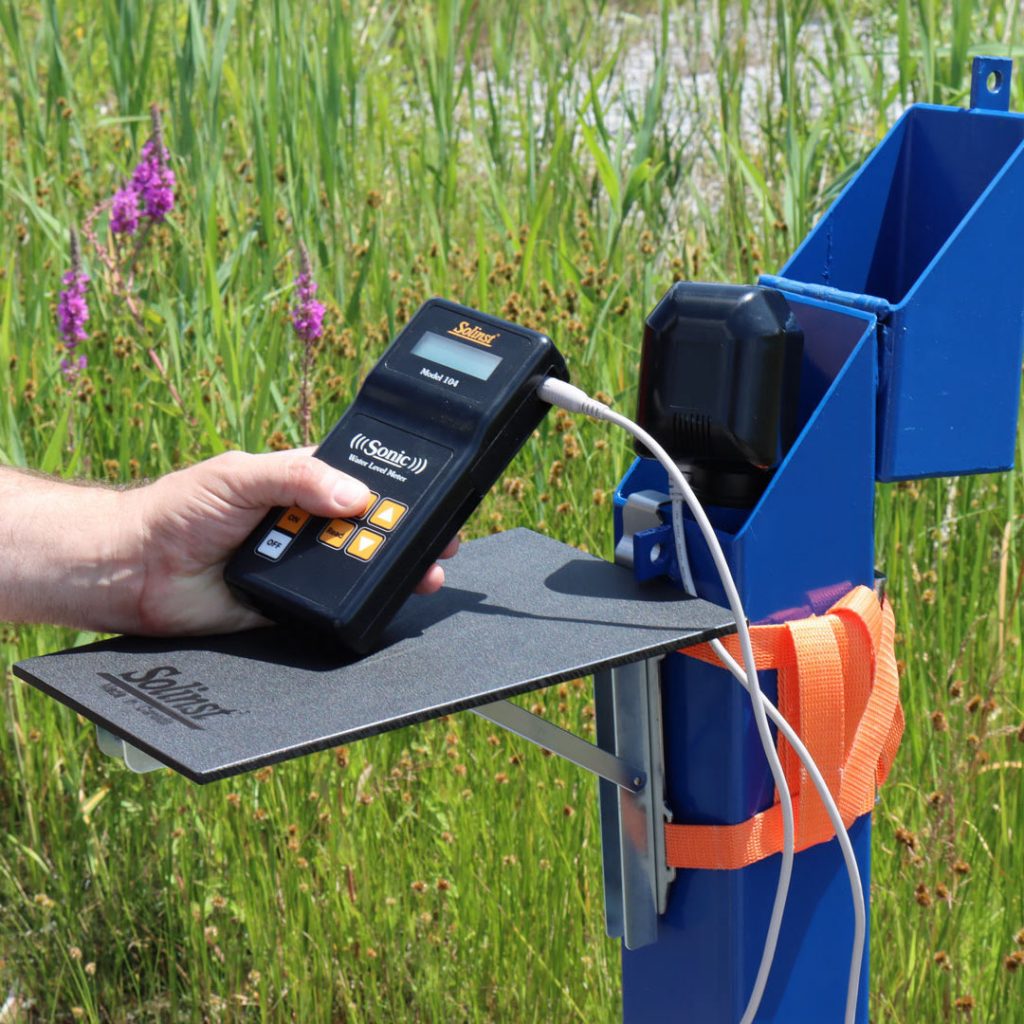
The 104 Solinst Sonic Water Level Meter is a portable, acoustic ranging instrument designed to simply and quickly provide depth to static water level measurements down to 600 m (2000 ft), without the need to lower equipment down a well. Ideal for straight, crooked, narrow, hard to access, or contaminated wells. Comes with a plastic disc for covering larger well openings and a convenient Solinst Field Bag.
Get a Quote!
If you still have questions, don’t worry, please feel free to contact one of our Technical Sales Representatives to see if the Solinst Model 104 Sonic Water Level Meter is right for your application.
